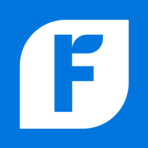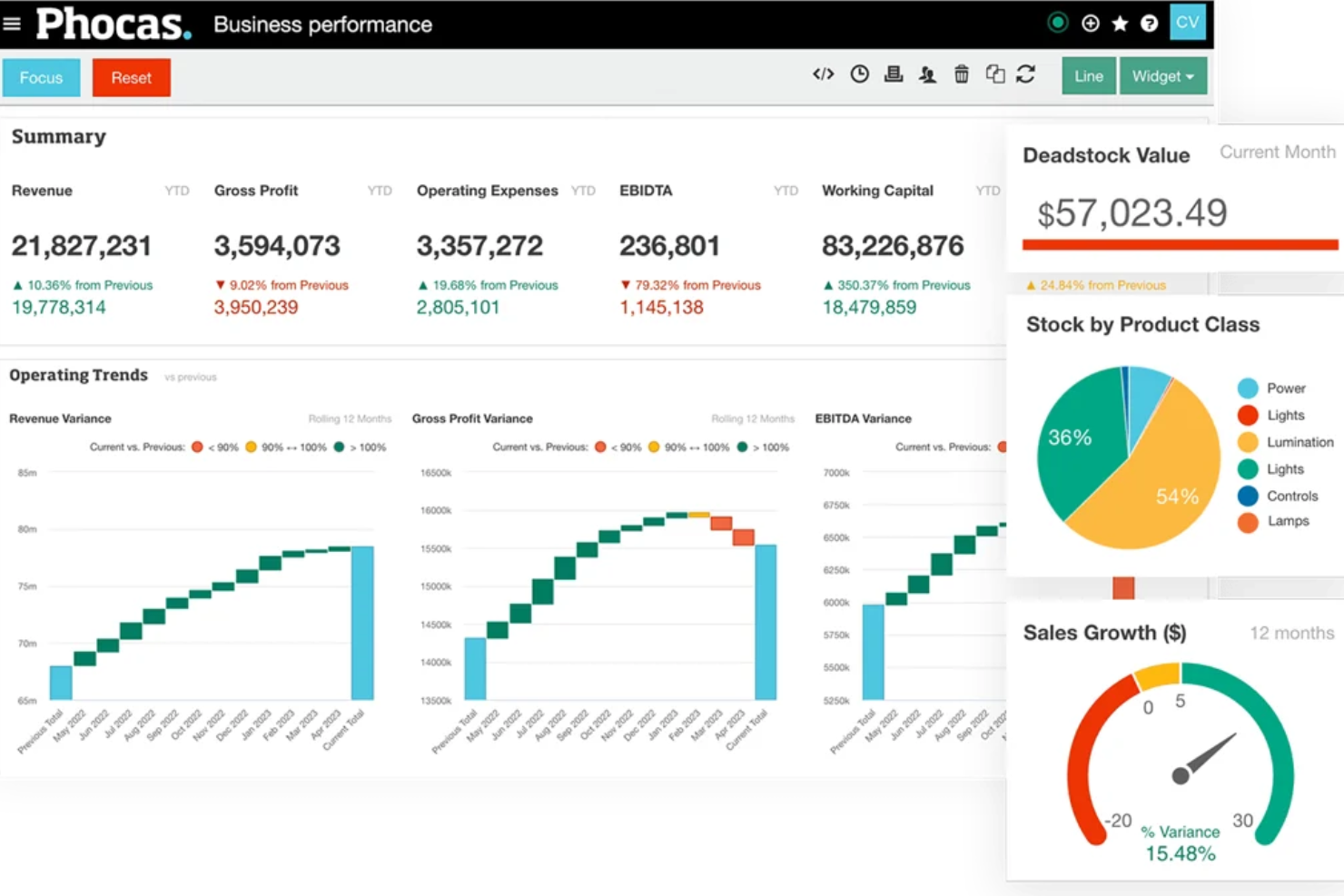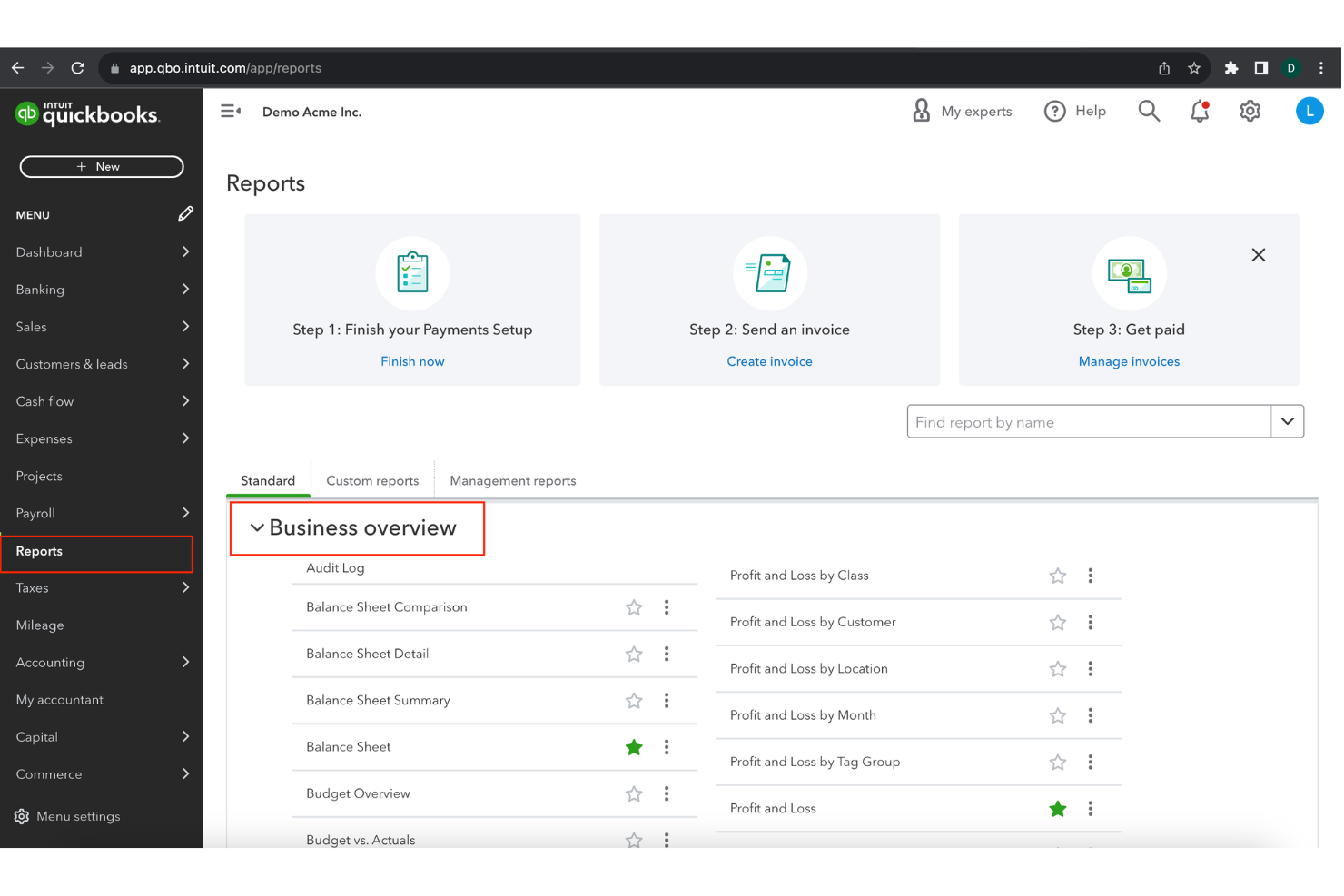Best Financial Reporting Software Shortlist
Here are the financial reporting solutions I’ve examined and selected to cover in this article:
Our one-on-one guidance will help you find the perfect fit.
Financial reporting software helps teams automate and streamline the creation of core financial statements, including income reports, balance sheets, and cash flow summaries. For CFOs and financial analysts in tech, the right tool reduces manual effort, supports compliance, and delivers accurate data for faster, more confident decision-making.
As a digital software expert with a background in financial management, I’ve worked closely with finance teams stuck between rising expectations and limited systems. I understand the challenge of pulling clean, consistent reports from scattered sources and the pressure that comes when leadership needs answers fast. Whether you're setting strategy or deep in the data, you need software that works with you, not against you.
That’s why I spent hours testing the top platforms and studying user feedback. The financial reporting software in this list is built to solve the problems you face daily, from tightening reporting cycles to improving clarity, so you can focus on driving results.
Why Trust Our Financial Software Reviews
My team and I have been testing and reviewing financial software since 2023. As current — or, ahem, historical — financial operators ourselves, we know how critical and difficult it is to make the right decision when selecting software.
We invest in deep research to help our audience make better software purchasing decisions. We’ve tested more than 2,000 tools for different finance use cases and written over 1,000 comprehensive software reviews. Learn how we stay transparent & our software review methodology.
Costs & Pricing for Financial Reporting Software
To kick things off, I collected pricing information about each tool. Here’s how they stack up, cost-wise:
| Tool | Best For | Trial Info | Price | ||
|---|---|---|---|---|---|
| 1 | Best for vendor payout data | Free demo available | Pricing upon request | Website | |
| 2 | Best for multidimensional reporting | Free demo available | Pricing upon request | Website | |
| 3 | Best for financial forecasting | Free demo available | Pricing upon request | Website | |
| 4 | Best for automated expense management | 30-day free trial + free plan available | From $15/user/month | Website | |
| 5 | Best for real-time financial visibility | 14-day free trial | From $25/month | Website | |
| 6 | Best for real-time spend pattern visibility | Free demo available | From $8/user/month (billed annually) | Website | |
| 7 | Best for Excel-powered financial reporting | Free demo + product tour available | Pricing upon request | Website | |
| 8 | Best for lease accounting reporting | Free demo available | Pricing upon request | Website | |
| 9 | Best for presentation-ready reports | 30-day free trial | From $10.50/month (for 3 months, then $35/month) | Website | |
| 10 | Best on a small budget | 30-day free trial | From $6.30/month (billed annually) | Website |
-

LiveFlow
Visit WebsiteThis is an aggregated rating for this tool including ratings from Crozdesk users and ratings from other sites.4.9 -

Float Financial
Visit Website -

Vena
Visit WebsiteThis is an aggregated rating for this tool including ratings from Crozdesk users and ratings from other sites.4.5
Reviews of the Best Financial Reporting Software for 2025
Here are the best financial management reporting software tools on the market going into 2025. I’ll go through the pros and cons of each tool, their features, and their ideal use cases.
Payouts.com is a specialized platform that supports businesses in automating and managing financial operations like payouts, vendor relationships, and invoicing. It caters particularly to companies in the affiliate marketing, influencer economy, and digital advertising spaces by integrating seamlessly with tracking systems like Tune, Affise, and CJ Affiliate.
Why I picked Payouts: Its payout automation capabilities allow businesses to manage large-scale payments efficiently, ensuring that creators, influencers, and partners are paid on time without errors. By integrating directly with tracking systems such as Tune and Affise, it provides a consolidated view of all transactions, giving you precise financial data to work with. This financial data is supported by real-time dashboards and custom reporting capabilities. Additionally, automatic invoice matching eliminates the need for manual reconciliation. By automating this process, Payouts reduces errors and speeds up the accounts payable workflow.
Standout Features and Integrations
Standout features include advanced data synchronization that ensures your financial systems and the Payouts platform are always aligned, providing real-time accuracy in reporting. The platform also offers efficient one-click payment execution, allowing you to pay anyone, anywhere, with minimal effort. Additionally, Payouts.com supports diverse payment options, including traditional bank transfers, eWallets, and cryptocurrencies.
Integrations include PayPal, Venmo, Payoneer, impact.com, CJ Affiliate, Everflow, Zelle, Priority, Tune, System1, and NetSuite.
Pros and cons
Pros:
- Supports scaling operations
- Multiple payout methods
- Comprehensive automation of accounts payable processes
Cons:
- May not integrate with all existing systems
- May require time to fully customize
DualEntry is an AI-native ERP built specifically for scaling operations. It’s designed to handle complex accounting and financial workflows with automation and intelligence at its core.
Why I Picked DualEntry: DualEntry stands out for its advanced reporting capabilities that go beyond basic financial statements. Its multidimensional reporting tools let you create custom reports tailored to your business needs, such as department-specific expense reports or month-over-month vendor comparisons. You can drag and drop to build custom reports, isolate specific accounts, and combine operating expenses for more focused analysis.
Standout Features and Integrations
Features include AI-driven features that can automatically categorize transactions, suggest new categories tailored to your operational focus, and identify anomalies before they become issues. DualEntry also offers dynamic allocations, simplifying complex allocation processes across products, projects, and departments.
Integrations include BambooHR, Bill.com, Brex, Deel, Google SSO, Gusto, HubSpot, Ramp, Rippling, Salesforce, Stripe Billing, and Stripe Invoicing.
Pros and cons
Pros:
- Automated revenue recognition ensures compliance with standards
- Supports multi-entity and multi-currency operations
- Advanced AI features help with complex accounting tasks
Cons:
- Customization options require careful setup
- No option to try the system before buying
Phocas is a business intelligence and financial analysis software designed to provide organizations with comprehensive data analytics, visualization, and reporting capabilities. It's specifically tailored for businesses seeking to enhance their data-driven decision-making processes as it integrates with various data sources, including ERP systems, CRM software, and other databases.
Why I picked Phocas: I chose Phocas because it offers customizable financial statements, including balance sheets, profit and loss statements, and cash flow reports, which can be tailored to meet the specific needs of any organization. The platform's ability to generate real-time financial reports ensures that businesses always have up-to-date information at their fingertips. Additionally, Phocas offers features for financial forecasting, allowing users to create detailed predictions based on historical data and trend analysis.
Standout Features and Integrations
Standout features include collaborative tools that enable users to share reports and dashboards with team members, data visualization tools to transform complex financial data into intuitive charts, graphs, and dashboards, and an AI feature that allows users to ask questions and receive relevant insights and reports quickly.
Integrations include Oracle, QAD, MAM Software, Khaos Control, SYSPRO, Retail Express, Sympac, Microsoft, Acumatica, Xero, Epicor, IFS, Sage, Accolent, MYOB, Enapps, Kerridge, SAP, Datafile, Netsuite, and more.
Pros and cons
Pros:
- Forecasting capabilities
- Real-time data and analytics
- Extensive customizations for reports and dashboards
Cons:
- Learning curve for new users wanting to maximize the features
- Set up and configuration can be time consuming
Ramp is a spend management platform that helps finance teams handle expenses, accounts payable, and financial reporting in one place. It automates key financial workflows so you can keep your reports accurate and up to date.
Why I Picked Ramp: I picked Ramp because it simplifies financial reporting by automating your expense management and accounts payable processes. You can snap a photo of a receipt, and Ramp automatically categorizes and codes the expense—no more manual data entry. I also like that Ramp’s built-in spend controls help you prevent out-of-policy purchases upfront, so you don’t have to fix mistakes later. These time-saving features give you the accurate, real-time financial data you need for reporting.
Standout Features and Integrations
Features include automated receipt capture, built-in approval workflows, and customizable spend controls to keep your budgets on track. Ramp also offers real-time reporting dashboards so you can see up-to-date financial activity across your company. On top of that, Ramp’s accounts payable tools let you process and pay hundreds of bills quickly, with no transaction fees.
Integrations include NetSuite, Sage, Xero, QuickBooks, Microsoft Dynamics Business Central, Acumatica, Uber, Lyft, Okta, Google, Rippling, and Gmail.
Pros and cons
Pros:
- Comprehensive reporting features
- Ability to issue multiple virtual cards with customizable controls
- Automated expense reporting and receipt matching
Cons:
- Mostly focuses on accounts payable and spend management
- Could offer more advanced accounting features
New Product Updates from Ramp
Vendor Approval Workflows in Ramp
Ramp's new vendor approval workflows allow teams or managers to review new vendors, ensuring compliance with procurement policies and preventing unauthorized entries. For more details, visit Ramp Announcements.
Puzzle.io is an AI-native accounting platform built for startups and small businesses. Its core functionality focuses on automating bookkeeping tasks like categorization, reconciliations, and accruals. On top of that foundation, Puzzle.io offers real-time reporting tools that allow you to review financial statements and monitor business health daily.
Why I picked Puzzle.io: I picked Puzzle.io for its ability to give you live access to key financial metrics without waiting for month-end closes. As transactions occur, Puzzle.io applies automated categorization and revenue recognition rules to keep your financials current. This allows you to track changes in cash, expenses, revenue, and burn rate as they happen. You can monitor variances between actual and expected results to identify unexpected shifts early, which may help you adjust decisions before problems escalate.
Standout Features and Integrations:
Standout features include dual cash and accrual books, customizable rule-based automation, continuous accuracy reviews, AI-powered categorization, variance analysis, real-time dashboards, and access to certified experts.
Integrations include Mercury, Ramp, Brex, Every, Meow, Rippling, Gusto, Deel, Central, Stripe, Bill.com, Runway, and Causal.
Pros and cons
Pros:
- Automates revenue recognition and expense categorization
- AI improves categorization accuracy over time
- Supports both cash and accrual accounting
Cons:
- Free trial requires users to connect a bank account
- Limited customization for complex workflows
New Product Updates from Puzzle.io
Puzzle.io's Automated PDF Statement Loading
Puzzle.io has introduced automated PDF statement loading for Meow, streamlining the reconciliation process by eliminating manual downloads and uploads. For more details, visit Puzzle.io Product Updates.
Rippling Spend is a tool designed to help businesses get a handle on spending by providing a centralized place for managing expenses, corporate cards, and budgets. With it, you can set up automated controls to ensure spending stays within your company’s guidelines.
Why I picked Rippling Spend: When it comes to financial reporting, Rippling Spend gives you solid tools to track and categorize every expense. You'll get detailed, real-time visibility into all spending activity, helping you understand exactly where your money is going. Its automated expense approvals reduce manual effort while ensuring compliance. Plus, its reporting features break down expenses by department, project, or employee, so you can quickly generate reports and gain insights into patterns that affect your financial decisions.
Standout Features and Integrations
Standout features include the ability to set up dynamic policy controls to prevent unauthorized spending before it happens. You can also manage employee reimbursements directly through the platform, ensuring everything is documented and handled efficiently. Additionally, Rippling Spend integrates corporate card management, giving you control over card usage while offering visibility into transactions in real-time.
Integrations include Slack, Google Workspace, Office 365, AWS, Zoom, Dropbox, and Salesforce.
Pros and cons
Pros:
- Dynamic policy enforcement helps prevent unauthorized spending
- Detailed reports for departments, projects, and employees
- Expense tracking helps with budgeting decisions
Cons:
- May offer more features than required for smaller operations
- Lacks advanced forecasting features
Vena is a flexible financial planning and analysis (FP&A) platform that automates key financial consolidation and reporting processes. It features a native Excel interface as well as integrations with Microsoft Power BI and PowerPoint, making it easy to adopt for most finance teams.
Why I picked Vena: I chose Vena for its easy-to-use Excel interface, custom reporting, and dashboard features, and ability to quickly integrate and consolidate data from ERP/GL, CRM, and HRIS systems. Additionally, as a financial reporting software, Vena provides robust planning and analysis features that include artificial intelligence for insightful financial data analysis, support for financial planning tasks, and data modeling capabilities for forecasting and scenario analysis.
Standout Features and Integrations
Standout features include audit trails, variance analysis, workflow management, scenario modeling, automated reconciliations, real-time dashboards, ad-hoc reporting, and collaboration tools.
Integrations include QuickBooks, Salesforce, Sage Intacct, Oracle, SAP, NetSuite, Microsoft Dynamics 365 Business Central, Dropbox, OneDrive, SFTP, and SharePoint. Custom integrations are available through Vena API.
Pros and cons
Pros:
- Usually quick to implement
- Preconfigured templates and reports
- Leverages familiar Excel interface
Cons:
- No mobile app
- Some compatibility issues with Mac
Spacebase is a modern lease accounting and management solution designed to help businesses efficiently handle their portfolios. It offers tools for managing leases, ensuring compliance with accounting standards, and streamlining reporting processes.
Why I picked Spacebase: I chose Spacebase for its ability to simplify compliance with accounting standards such as ASC 842 and IFRS 16. The platform provides guided checklists to classify leases as operating, finance, or short-term, helping your team adhere to regulatory requirements without hassle. This feature ensures that your financial reports are accurate and compliant, reducing the risk of errors during audits. You can also build tailored reports and exports to access the specific data your team needs. This flexibility allows for detailed financial analysis and supports informed decision-making.
Standout Features and Integrations
Standout features include a centralized dashboard that offers a comprehensive overview of your lease portfolio, displaying critical dates, rent obligations, and portfolio metrics. Automated alerts and notifications ensure you never miss important dates or payments by highlighting them prominently on the dashboard. Additionally, the lease notes system aggregates user comments and updates, facilitating communication among team members regarding lease actions or changes.
Integrations include Workday, NetSuite, Tableau, Okta, OneLogin, and Oracle Cloud Financials.
Pros and cons
Pros:
- Custom reporting features allow tailored financial analysis
- Ensures compliance with lease accounting standards like ASC 84
- Effective tracking and management of rent, leases, and important real estate files
Cons:
- No mobile app
- Could offer more native integration options
QuickBooks Online is a cloud-based accounting software tailored for small to midsize businesses, offering a wide range of financial management tools such as invoicing, expense tracking, payroll management, and tax preparation.
Why I picked QuickBooks Online: It provides presentation-ready reports that can be tailored to meet the specific needs of stakeholders, which is crucial for precision in financial presentations. These reports are supported by real-time insights available through financial statements and a revenue streams dashboard, offering a dynamic view of the company's financial health. The ability to monitor cash flow trends and create personalized dashboards for key performance indicators (KPIs) also drives informed, data-driven decisions.
Standout Features and Integrations
Standout features include automated invoicing and bill payments, reducing time spent on routine tasks, and tools for collaboration and data management. Other features include project profitability tracking and inventory management, which are vital for businesses handling both products and services.
Integrations include Amazon Business, PayPal, Square, Etsy, eBay, Shopify, Google Sheets, Salesforce, Stripe, HubSpot, and Mailchimp.
Pros and cons
Pros:
- Compatible with a wide range of apps
- Good for scaling businesses
- Users can tailor financial reports to meet specific business needs
Cons:
- Potential for errors in general ledger due to auto-population issues
- Bank feed rules can lead to errors
Freshbooks is accounting software that’s very affordable and easy to use, which I think is ideal for small businesses, freelancers, and solopreneurs.
Why I picked Freshbooks: I added Freshbooks to my list because it’s a great all-around solution for small businesses and freelancers who don’t need the complex financial reporting software that makes up most of this list.
Standout Features and Integrations
Standout features include annual and interim financial statements, bank account synchronization, and detailed tax reporting.
In addition to the basic financial reporting functionality, I like that Freshbooks also gives you tools for invoicing, client management, payments, and expense management.
Integrations include Hubspot, QuickBooks, Google Sheets, PayPal, Gmail, WooCommerce, Square, and Shopify.
Pros and cons
Pros:
- Customizable invoices and email templates
- Connects with your bank for easy reconciliation
- Easy-to-use
Cons:
- No full audit trail
- Limits on billable clients
Other Financial Reporting Software Options
Here are some more financial reporting tools that didn’t make the top 12 but are still worth checking out.
- Xero
For startups
- Workiva
For complex reporting
- Sage Business Cloud Accounting
For small businesses
- Tipalti
For large organizations
- insightsoftware
For custom reporting
- Xledger
For complex ERP needs
- Tagetik
Comprehensive solution
- Cube
For growing teams
- LicenceOne
For SaaS spend optimization
- Spreadsheet Server
For live data reports
Related Finance and Accounting Software Reviews
In the market for some other finance and accounting software as well? Check out these reviews:
- Forecasting Software
- Billing Software
- Expense Tracking Software
- Payroll Services
- Retail POS Systems
- Inventory Management Software
Selection Criteria For Financial Management Reporting Software
Selecting the best financial reporting software involves evaluating its functionality and how well it meets specific use cases. The criteria relate to the needs and pain points of software buyers, ensuring the tool is suitable for its intended use.
Here's what I thought mattered most:
Core Financial Reporting Software Functionality: 25% of Total Weighting Score
- Generating financial statements
- Budgeting and forecasting
- Compliance and audit support
- Consolidation of financial data
- Real-time financial analysis
Additional Standout Features: 25% of Total Weighting Score
- Advanced data visualization tools
- Integration with other business systems (e.g., ERP, CRM)
- Customizable reporting templates
- AI-driven insights and predictive analytics
- Mobile accessibility for on-the-go reporting
Usability: 10% of Total Weighting Score
- Intuitive user interface
- Drag-and-drop report builders
- Customizable dashboards
- Role-based access control
- Minimal learning curve
Onboarding: 10% of Total Weighting Score
- Availability of training videos and tutorials
- Interactive product tours
- Pre-built templates for quick setup
- Chatbots for instant support
- Webinars for in-depth training
Customer Support: 10% of Total Weighting Score
- 24/7 availability
- Multiple support channels (phone, email, chat)
- Dedicated account managers
- Comprehensive knowledge base
- Fast response times
Value For Money: 10% of Total Weighting Score
- Competitive pricing models
- Transparent pricing structure
- Flexible subscription plans
- Cost-benefit analysis
- Discounts for long-term commitments
Customer Reviews: 10% of Total Weighting Score
- Overall satisfaction ratings
- Commonly reported issues
- Praise for specific features
- Feedback on customer support
- User testimonials and case studies
How to Choose Financial Reporting Software
It’s easy to get bogged down in long feature lists and complex pricing structures. To help you stay focused as you work through your unique software selection process, here’s a checklist of factors to keep in mind:
| Factor | What to Consider |
|---|---|
| Scalability | Will the software grow with your business? Consider if it can handle increased data volume or more users without a hitch. |
| Integrations | Does it integrate with your existing systems? Check compatibility with ERP systems, CRM, and other tools to avoid data silos. |
| Customizability | Can you tailor it to fit your needs? Look for options to adjust reports and dashboards to match your specific workflows. |
| Ease of Use | Is the interface user-friendly? Ensure your team can quickly adopt it without extensive training. |
| Implementation and Onboarding | How long will setup take? Consider the time and resources required to get up and running, and whether vendor support is available during this phase. |
| Cost | What’s the total cost of ownership? Beyond the sticker price, consider subscription fees, training, and maintenance expenses. |
| Security Safeguards | Are your data protected? Look for features like encryption, two-factor authentication, and regular security audits. |
| Compliance Requirements | Does it meet industry standards? Ensure it adheres to regulations like SOX or IFRS if applicable to your business. |
Financial Reporting Software Trends in 2025
Financial reporting software is evolving in many of the same ways as other financial software, though there are few unique things to pay attention to. Here are some key trends financial reporting software saw in 2025.
AI and Machine Learning Integration
AI and machine learning are being integrated into financial reporting software. These technologies, combined with any type of statistical analysis software, help automate data analysis and provide predictive insights. This trend is important for improving decision-making accuracy.
Real-Time Data Processing
Real-time data processing is becoming a standard feature. It allows businesses to access up-to-the-minute financial information. This is crucial for timely decision-making and maintaining a competitive edge. It's also beneficial if you need to make budgets.
Blockchain for Enhanced Security
Blockchain technology is being adopted for financial reporting. It offers enhanced security and transparency in financial transactions. This trend is significant for reducing fraud and ensuring data integrity.
Cloud-Based Solutions
Cloud-based financial reporting solutions are on the rise. They offer scalability and remote access to financial data. This is particularly important for businesses with distributed teams.
Customizable Dashboards
Customizable dashboards are gaining popularity. They allow users to tailor their financial reports to specific needs. This trend is valuable for providing personalized insights and improving user experience.
What is Financial Reporting Software?
Financial reporting software is a tool that helps businesses create, analyze, and share financial statements automatically. It’s used to generate reports like balance sheets, income statements, and cash flow statements, often in real time.
This software reduces manual work, improves accuracy, and supports compliance with accounting standards. Finance teams, accountants, and CFOs use it to ensure compliance, track performance, and support data-driven decision-making.
Features Of Financial Reporting Software
When I’m choosing financial reporting software, I focus on what truly saves time and ensures accuracy. You probably do too.
The right tool helps me move fast, stay compliant, and see the big picture clearly. Here’s what I look for in software that actually delivers results:
- User-Friendly Interface: A simple and intuitive interface ensures that users can navigate the software easily, reducing the learning curve and increasing productivity.
- Customizable Reports: The ability to customize reports allows you to tailor the financial data to meet specific business needs, providing more relevant insights.
- Real-Time Data Access: Access to real-time data ensures that you are always working with the most current information, which is crucial for making timely decisions.
- Integration Capabilities: Seamless integration with other business systems, such as ERP and CRM, ensures that data flows smoothly across different platforms, reducing the risk of errors.
- Automated Processes: Automation of routine tasks, such as data entry and report generation, saves time and reduces the likelihood of human error.
- Security Features: Robust security measures protect sensitive financial data from unauthorized access and breaches, ensuring compliance with regulatory requirements.
- Scalability: The software should be able to grow with your business, accommodating increasing amounts of data and more complex reporting needs as your company expands.
- Collaboration Tools: Features that facilitate collaboration, such as shared access and real-time updates, enable team members to work together more effectively.
- Mobile Access: The ability to access the software from mobile devices ensures that you can manage your financial data on the go, providing flexibility and convenience.
- Customer Support: Reliable customer support ensures that any issues or questions are addressed promptly, minimizing downtime and disruptions to your financial processes.
Benefits Of Financial Reporting Software
With the best financial reporting software, you can boost speed, reduce manual errors, and gain clearer insights. But these aren't the only benefits of this software.
If you’re looking to streamline processes and stay ahead, here are five key benefits worth knowing:
- Improved Accuracy: Financial reporting software reduces the risk of human error by automating calculations and data entry, ensuring that financial reports are accurate and reliable.
- Time Efficiency: By automating repetitive tasks and streamlining data collection, financial reporting software saves valuable time for finance teams, allowing them to focus on more strategic activities.
- Enhanced Data Analysis: The software provides advanced analytical tools that enable users to gain deeper insights into financial data, helping organizations make informed decisions based on comprehensive analysis.
- Regulatory Compliance: Financial reporting software helps organizations stay compliant with regulatory requirements by automatically updating to reflect changes in financial reporting standards and providing audit trails.
- Real-Time Reporting: With real-time data processing capabilities, financial reporting software allows users to generate up-to-date financial reports quickly, facilitating timely decision-making and improving overall business agility.
Costs And Pricing Of Financial Reporting Software
This section provides an estimate of average financial reporting software plans and costs. The pricing varies based on the plan type and the features offered:
| Plan Type | Average Price (per month) | Common Features |
|---|---|---|
| Free | ... it's free! | Basic income/expense tracking, invoicing, limited reporting capabilities |
| Personal | $10 - 50 | Income/expense tracking, invoicing, basic financial statements, limited users |
| Business | $50 - 150 | Multi-user access, recurring invoicing, expense reporting automation, payroll |
| Enterprise | $150+ | Customizable fields, automated reporting, project costing, advanced integrations |
Financial Reporting Software FAQs
Here are my answers to some common questions people have about financial reporting software.
What integrations should I prioritize in financial reporting software?
Prioritize integrations with your main accounting platform, ERP, payroll software, and any BI or budgeting tools. Make sure to consider future needs, too. Look for enterprise financial reporting software that offers open APIs or direct connections to other core systems.
How can financial reporting software improve audit readiness or compliance?
The best financial reporting software makes audits smoother by automating record keeping, maintaining detailed version histories, and offering built-in compliance workflows. Features like audit logs, user activity tracking, and document management ensure every financial change is documented and traceable.
This transparency lets you respond quickly to audit requests and minimizes the scramble to assemble supporting documentation.
How do financial reporting tools handle data security and access controls?
Most financial reporting software solutions use enterprise-grade encryption for data storage and transfers. They also support multi-factor authentication and let you set detailed user roles.
Regular security audits, audit logs, and customizable permission levels also make it easier to meet company policies and regulatory requirements. This helps ensure confidential data stays protected as your team grows or changes.
How does financial consolidation and reporting software simplify group or multi-entity reporting?
Financial consolidation and reporting software aggregates data from multiple subsidiaries, locations, or business units in real time. These tools automate intercompany eliminations, currency conversions, and adjustments for differing accounting standards.
Built-in templates and workflows also ensure consistency across group reports, even as your company structure evolves. You get complete, up-to-date consolidated statements quickly, so you easily meet group-level compliance needs.
Is Excel a financial reporting system?
No, Excel’s not a full-fledged financial reporting system. Rather, it’s a versatile spreadsheet tool. While you can use it for reports, Excel requires manual data entry, lacks audit trails, and doesn’t connect natively to accounting software or ERPs. Financial reporting software offers automatic data imports, built-in compliance checks, multi-user permissions, and templated reports.
Does cloud-based reporting software offer better scalability for growing companies?
Yes, cloud-based software makes scaling your finance operations easy. You can add new users, entities, or currencies as needed without the cost or hassle of new hardware.
Cloud systems also let your team collaborate on reports from anywhere and ensure everyone’s always using the latest data. With automatic updates and security patches, you can free up IT resources and keep your reporting environment current.
Subscribe For More Fintech Insights
Subscribe to our free newsletter for expert advice, guides, and insights from finance leaders shaping the tech industry.
























